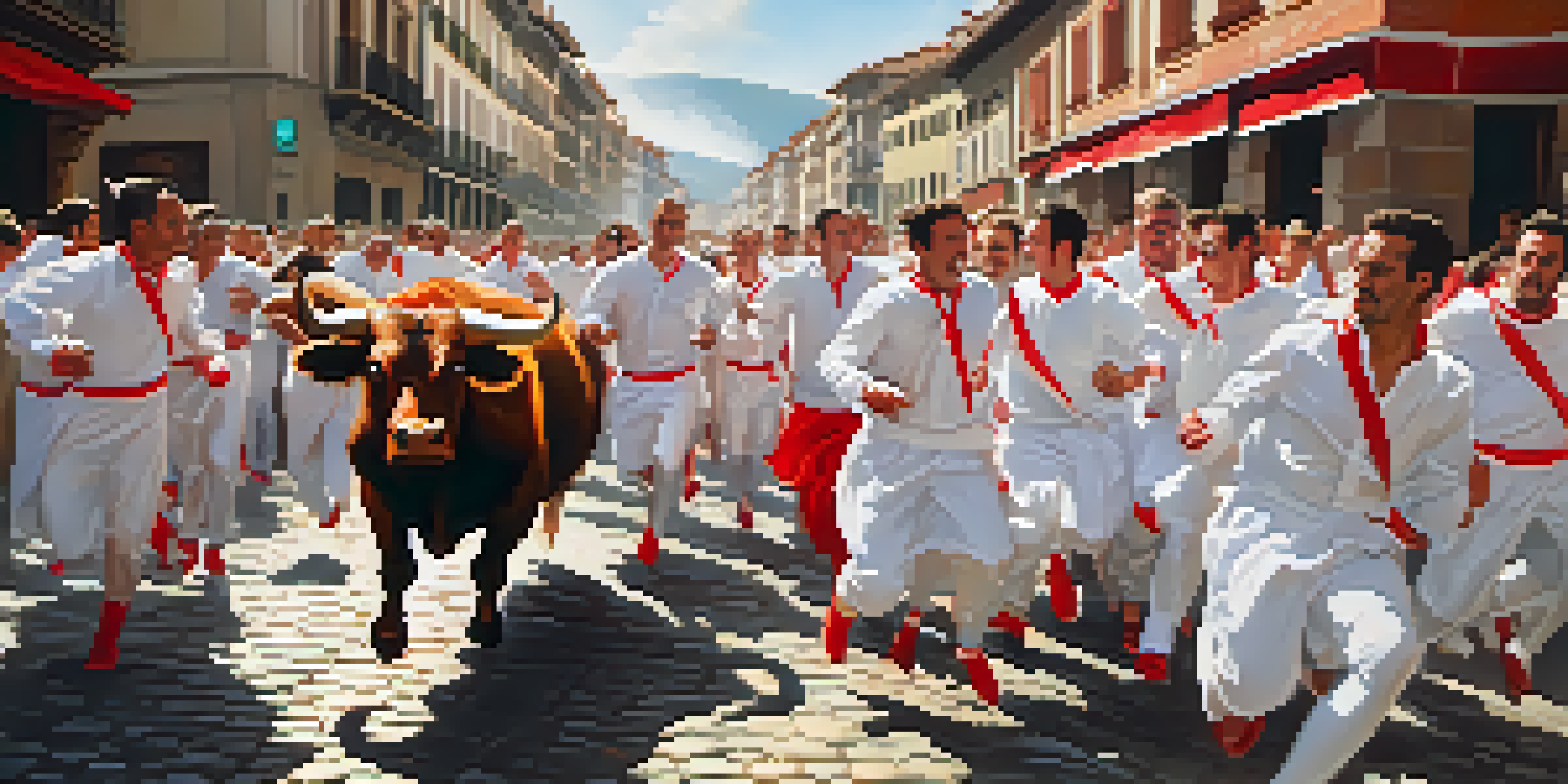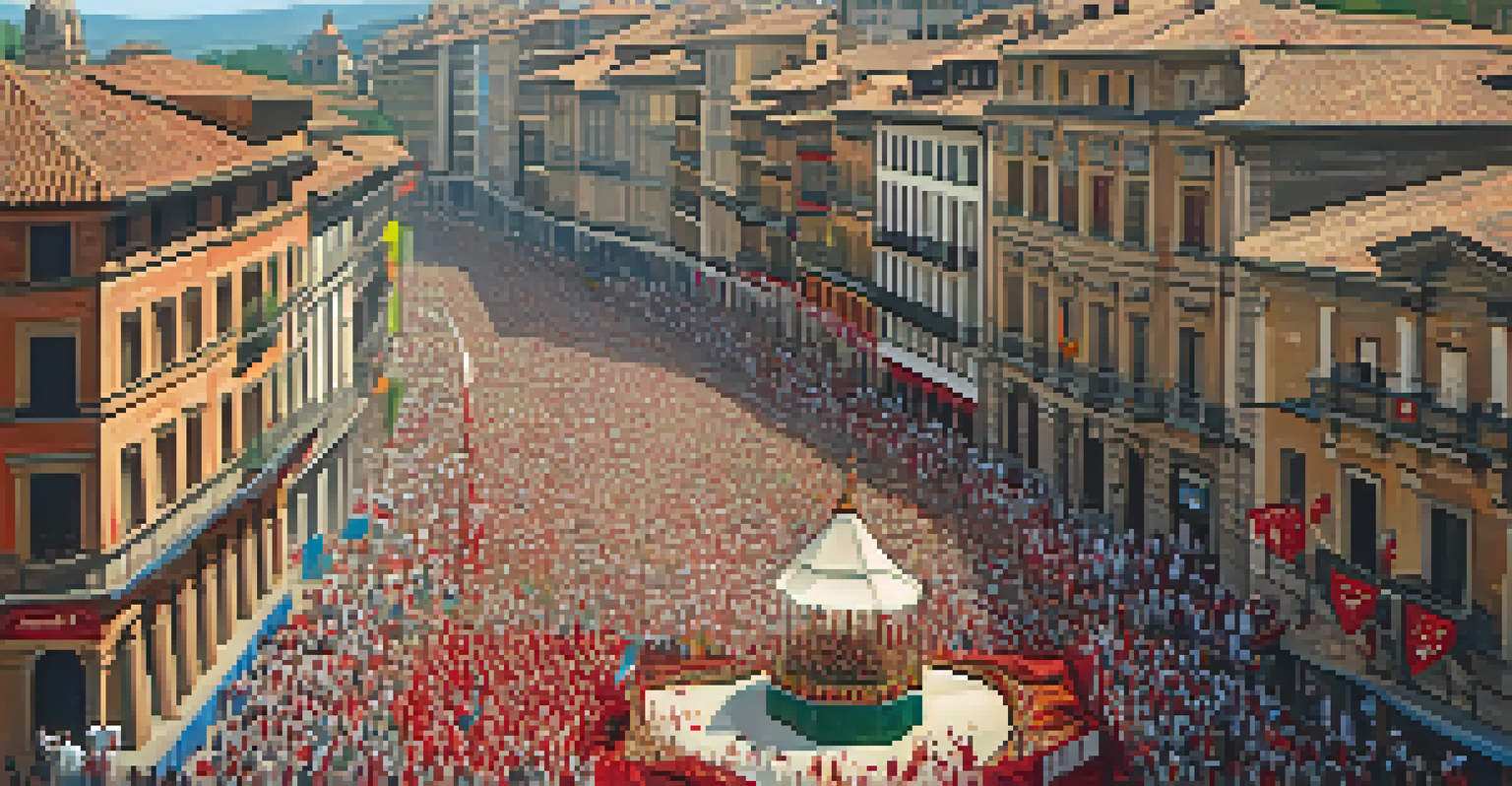Exploring the Unique Culture of the Running of the Bulls

A Glimpse into the History of the Running of the Bulls
The Running of the Bulls, or 'Encierro,' has deep roots in Spanish culture, particularly in Pamplona, where it has been celebrated for centuries. This event typically takes place during the San Fermín festival, which dates back to the 13th century. Originally, it served as a way to transport bulls from the outskirts of the city to the bullring for the evening's festivities.
Tradition is not the worship of ashes, but the preservation of fire.
Over the years, what began as a practical necessity evolved into a thrilling spectacle that attracts thousands of visitors. The blend of adrenaline and tradition has transformed the event into a cornerstone of local identity. People from all over the globe converge in Pamplona, eager to witness or partake in this unique experience.
Understanding the historical context of the Running of the Bulls enriches the experience for both participants and spectators. It’s not just about the rush; it's about honoring the traditions that have shaped this iconic celebration.
The Thrill of the Run: What to Expect
For many, the Running of the Bulls is about the thrill of sprinting alongside these majestic animals. Participants, known as 'mozos,' prepare mentally and physically for the challenge ahead. The run takes place in a confined space, where the bulls charge down the streets, creating a heart-pounding atmosphere that is both exhilarating and dangerous.

Before the run begins, a rocket is fired to signal the start, instantly sending adrenaline levels soaring. The streets become a flurry of excitement, with cheers and shouts echoing off the walls. The rush of adrenaline is palpable as participants try to outpace the bulls while ensuring their safety.
Rich History of the Event
The Running of the Bulls, rooted in the San Fermín festival, has evolved from a practical necessity into a thrilling cultural spectacle.
While the event is often romanticized, it is essential to understand the risks involved. Each year, injuries occur, reminding everyone that this is not just a game, but a serious event steeped in tradition and thrill.
Cultural Significance Beyond the Run
The Running of the Bulls is more than just a race; it's a celebration of Spanish culture and community. The San Fermín festival encompasses music, dance, food, and camaraderie, making it a vibrant cultural experience. Locals and visitors alike engage in various festivities that honor tradition and create lasting memories.
Culture is the widening of the mind and of the spirit.
One of the festival's highlights is the daily parades, featuring colorful costumes and lively music. This creates a festive atmosphere that enhances the excitement surrounding the run. It’s a time when people come together, regardless of their backgrounds, sharing in the joy of the celebration.
Moreover, the event fosters a sense of pride among the locals, who take great care in preserving their customs. This cultural significance is what makes the Running of the Bulls a unique phenomenon that extends beyond the mere thrill of the chase.
Safety Measures and Controversies
While the Running of the Bulls is steeped in tradition, safety remains a paramount concern. Organizers have implemented various measures to minimize risks for both participants and bulls. These include designated routes, strict regulations, and experienced runners who guide newcomers.
Despite these precautions, the event has faced criticism from animal rights activists. Many argue that the practice is inhumane and should be abolished. This ongoing debate highlights the tension between tradition and modern ethical considerations.
Cultural Significance and Community
Beyond the run, the festival celebrates Spanish culture through music, food, and community, creating a vibrant atmosphere for all.
Understanding both sides of the argument is crucial for a well-rounded perspective. While many cherish the tradition, it's essential to engage in conversations about animal welfare, ensuring that future generations can enjoy the festival in a responsible manner.
Experiencing the Festivities: A Visitor's Guide
For those planning to join the festivities, preparation is key to fully enjoying the experience. Arriving early is advisable to secure a good spot for viewing the run and immersing yourself in the festival's atmosphere. It's also wise to familiarize yourself with the event schedule, ensuring you don’t miss out on any key moments.
Dress appropriately for the occasion—white clothing with red accessories is traditional and helps participants feel part of the celebration. Comfortable shoes are a must, especially if you plan to run or walk through the bustling streets of Pamplona.
Lastly, embrace the spirit of the festival. Engage with locals, try traditional foods, and participate in the various activities that create a sense of community. The Running of the Bulls is not just an event; it’s a vibrant cultural tapestry waiting to be explored.
Local Cuisine: A Taste of Pamplona
No visit to Pamplona would be complete without indulging in the local cuisine. The city offers a delicious array of traditional dishes that reflect its rich culture. From pintxos—small snacks served in bars—to hearty stews, there is something to please every palate.
One must-try dish is 'chistorra,' a flavorful sausage often served in a sandwich. Pairing it with a local wine or cider enhances the culinary experience, making each bite a celebration of taste. The vibrant food scene is an integral part of the San Fermín festival, bringing people together over shared meals.
Safety and Ethical Concerns
While safety measures are in place for the event, ongoing debates about animal welfare highlight the tension between tradition and modern ethics.
Exploring local markets and tasting traditional fare can deepen your appreciation for the culture. Food plays a significant role in the festivities, creating connections that go beyond just the thrill of the run.
The Global Impact of the Running of the Bulls
The Running of the Bulls has transcended its local roots, becoming a global phenomenon that attracts tourists from around the world. This influx of visitors not only boosts the local economy but also fosters cultural exchange. Tourists leave with stories and experiences that highlight the uniqueness of Spanish traditions.
However, this global attention also raises questions about the preservation of local customs. As the event grows in popularity, there’s a fine line between maintaining authenticity and catering to tourism. Balancing these aspects is crucial for the future of the Running of the Bulls.

Ultimately, the global impact of the event illustrates the power of cultural traditions to unite people across boundaries. The shared experience of the Running of the Bulls continues to inspire and connect individuals, fostering a deeper understanding of Spanish culture.